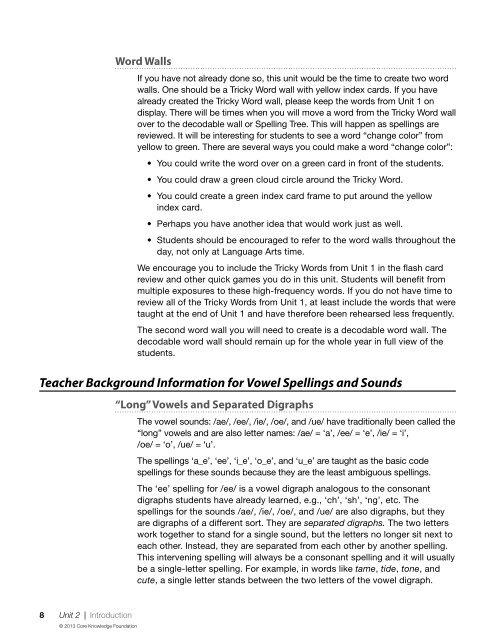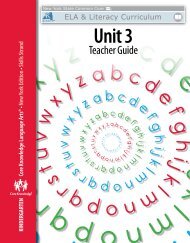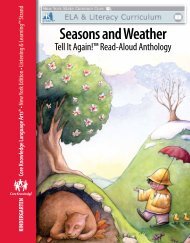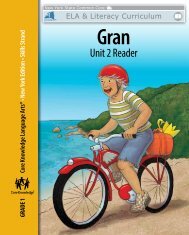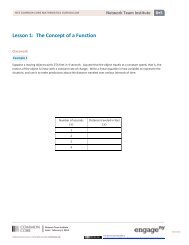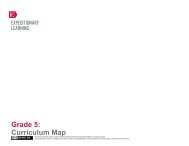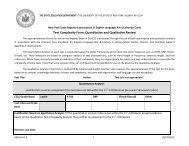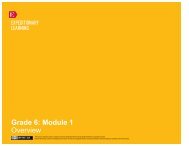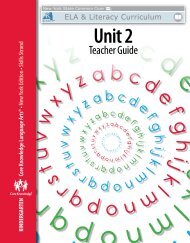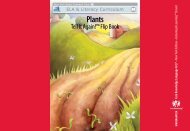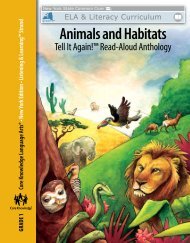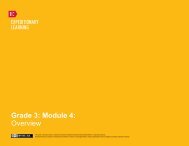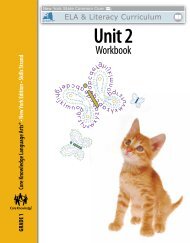Skills Unit 2 Teacher Guide - EngageNY
Skills Unit 2 Teacher Guide - EngageNY
Skills Unit 2 Teacher Guide - EngageNY
Create successful ePaper yourself
Turn your PDF publications into a flip-book with our unique Google optimized e-Paper software.
Word Walls<br />
If you have not already done so, this unit would be the time to create two word<br />
walls. One should be a Tricky Word wall with yellow index cards. If you have<br />
already created the Tricky Word wall, please keep the words from <strong>Unit</strong> 1 on<br />
display. There will be times when you will move a word from the Tricky Word wall<br />
over to the decodable wall or Spelling Tree. This will happen as spellings are<br />
reviewed. It will be interesting for students to see a word “change color” from<br />
yellow to green. There are several ways you could make a word “change color”:<br />
• You could write the word over on a green card in front of the students.<br />
• You could draw a green cloud circle around the Tricky Word.<br />
• You could create a green index card frame to put around the yellow<br />
index card.<br />
• Perhaps you have another idea that would work just as well.<br />
• Students should be encouraged to refer to the word walls throughout the<br />
day, not only at Language Arts time.<br />
We encourage you to include the Tricky Words from <strong>Unit</strong> 1 in the flash card<br />
review and other quick games you do in this unit. Students will benefit from<br />
multiple exposures to these high-frequency words. If you do not have time to<br />
review all of the Tricky Words from <strong>Unit</strong> 1, at least include the words that were<br />
taught at the end of <strong>Unit</strong> 1 and have therefore been rehearsed less frequently.<br />
The second word wall you will need to create is a decodable word wall. The<br />
decodable word wall should remain up for the whole year in full view of the<br />
students.<br />
<strong>Teacher</strong> Background Information for Vowel Spellings and Sounds<br />
“Long” Vowels and Separated Digraphs<br />
The vowel sounds: /ae/, /ee/, /ie/, /oe/, and /ue/ have traditionally been called the<br />
“long” vowels and are also letter names: /ae/ = ‘a’, /ee/ = ‘e’, /ie/ = ‘i’,<br />
/oe/ = ‘o’, /ue/ = ‘u’.<br />
The spellings ‘a_e’, ‘ee’, ‘i_e’, ‘o_e’, and ‘u_e’ are taught as the basic code<br />
spellings for these sounds because they are the least ambiguous spellings.<br />
The ‘ee’ spelling for /ee/ is a vowel digraph analogous to the consonant<br />
digraphs students have already learned, e.g., ‘ch’, ‘sh’, ‘ng’, etc. The<br />
spellings for the sounds /ae/, /ie/, /oe/, and /ue/ are also digraphs, but they<br />
are digraphs of a different sort. They are separated digraphs. The two letters<br />
work together to stand for a single sound, but the letters no longer sit next to<br />
each other. Instead, they are separated from each other by another spelling.<br />
This intervening spelling will always be a consonant spelling and it will usually<br />
be a single-letter spelling. For example, in words like tame, tide, tone, and<br />
cute, a single letter stands between the two letters of the vowel digraph.<br />
8 <strong>Unit</strong> 2 | Introduction<br />
© 2013 Core Knowledge Foundation


